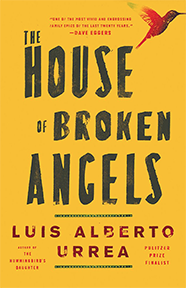The House of Broken Angels
Big Angel is gathering everyone for one last birthday party, and your invited!
Pulitzer Prize Finalist Luis Alberto Urrea begins The House of Broken Angels by simply thrusting the reader into the world of the de La Cruzes without much context, but within the first few pages, we learn that Big Angel, the family patriarch, is on his way to bury his one-hundred-year-old mother the day before his seventieth birthday, which will be his last as his body withers from cancer. The de La Cruzes family tree is then explored throughout Big Angel’s final birthday party–a setting that dominates a majority of the novel–as he has invited everyone who he possibly could. In order for one to see the family tree though, the reader must be highly attentive–in a way one would be if surrounded by strangers in an unknown area–of every character, their dialogue, and interactions with one another. While Urrea tasks the reader with puzzling various names and relationships together, he sums up how long the La Cruz family has lived in the United States early on, when Big Angel and his family drive past a “Build the Wall” sign.
“…the de La Cruz family has been around here since before your grandparents were even born.”
As the family tree of the de La Cruzes begins to unfold, so do the problems that come along with each character. Many of the problems and encounters that are explored begin with the issues of border-crossing back and forth between Tijuana and California, but move toward issues that are contemporary and of high importance to Mexican-American families. For instance, there are two characters who find themselves ostracized for long periods time for reasons that are still common today. Little Angel finds himself ostracized from his half-brother, Big Angel, and others in the de La Cruz family because he is biracial: he is half-white and half-Mexican. Little Angel is often considered too white, a gringo, to Big Angel and the elders of the de La Cruz family; on the other hand, Little Angel is viewed as simply Hispanic by all others outside of the family. For example, Little Angel is involved in a scene with a Target shopper telling Little Angel that he will be deported soon. All the while, Yndio, Big Angel’s oldest step-son, disappears from the family for many years after Yndio’s non-cisgender identity is revealed to Big Angel and the rest of the de La Cruz family.
Other issues explored by Urrea involve military recruitment practices and assimilation to unknown aspects US culture. Lalo, another one of Big Angel’s children, is solicited to enlist in the military with the promise of a pathway to US citizenship but is deported to Mexico after serving in Iraq, having to reenter the US by crossing the border. This leads to drug-abuse and other outbreaks of symptoms related to PTSD that neither Lalo nor his family seem to be aware of. Big Angel’s American born nephew Marco, a metal-head who goes by the alias of The Satanic Hispanic, doesn’t interact much with the de La Cruzes at Big Angel’s party, but is smitten with a blind girl named Lily.
While the main story focuses on the de La Cruz family and many of the challanges they face, there are moments of beauty that may go unnoticed, such as Big Angel’s lifelong marriage to his wife Perla, a couple that seems to remain in love with each other as if there were teenagers after decades of marriage, or the way that the de La Cruz family is able to find some level of reconciliation amongst each other without any more dignity ravished from one another.
The House of Broken Angels is a novel that appropriately veers between heavy moments of disaster and beauty, with small dashes of humor, to serve as a testament to the struggles that many Mexican-American families face–many of which that are hardly discussed, but are all too real and common. This novel provokes the discussions ignored, while at the same time, finding a way to humanize the perceptions of immigrants, immigration, non-cisgender identities, and those attempting to balance a multiracial identity.
Reviewed by Carlos Joshue Reyes
Published by Little, Brown and Company on March 6, 2018
ISBN: 978-0-0-316-15488-8
336 Pages

